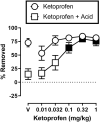Effects of Ketoprofen and Morphine on Pain-Related Depression of Nestlet Shredding in Male and Female Mice
- PMID: 34485976
- PMCID: PMC8415797
- DOI: 10.3389/fpain.2021.673940
Effects of Ketoprofen and Morphine on Pain-Related Depression of Nestlet Shredding in Male and Female Mice
Abstract
A primary goal in pain treatment is restoration of behaviors that are disrupted by pain. Measures of pain interference indicate the degree to which pain interferes with activities in pain patients, and these measures are used to evaluate the effects of analgesic drugs. As a result of the emphasis on the expression and treatment of functional impairment in clinical settings, preclinical pain researchers have attempted to develop procedures for evaluation of pain-related functional impairment in laboratory animals. The goal of the present study was to develop and validate a low cost procedure for the objective evaluation of pain-related depression of home cage behavior in mice. On test days, a 5 × 5 cm Nestlet was weighed prior to being suspended from the wire lid of the home cage of individually housed male and female ICR mice. Over the course of experimental sessions, mice removed pieces of the suspended Nestlet, and began to build a nest with the material they removed. Thus, the weight of the pieces of Nestlet that remained suspended at various time points in the session provided an indicator of the rate of this behavior. The results indicate that Nestlet shredding was stable with repeated testing, and shredding was depressed by intra-peritoneal injection of 0.32% lactic acid. The non-steroidal anti-inflammatory drug ketoprofen blocked 0.32% lactic acid-induced depression of shredding, but did not block depression of shredding by a pharmacological stimulus, the kappa opioid receptor agonist U69,593. The μ-opioid receptor agonist morphine did not block 0.32% lactic acid-induced depression of shredding when tested up to doses that depressed shredding in the absence of lactic acid. When noxious stimulus intensity was reduced by decreasing the lactic acid concentration to 0.18%, morphine was effective at blocking pain-related depression of behavior. In summary, the data from the present study support consideration of the Nestlet shredding procedure for use in studies examining mechanisms, expression, and treatment of pain-related functional impairment.
Keywords: behavior; depression; impairment; ketoprofen; morphine; nesting; pain.
Conflict of interest statement
Conflict of Interest: The authors declare that the research was conducted in the absence of any commercial or financial relationships that could be construed as a potential conflict of interest.
Figures





References
-
- Institute of Medicine Committee on Advancing Pain Research C Education . The National Academies Collection: Reports funded by National Institutes of Health. In: Relieving Pain in America: A Blueprint for Transforming Prevention, Care, Education, and Research. Washington, DC: National Academies Press (US) (2011). - PubMed
-
- NIH . Estimates of Funding for Various Research, Condition, and Disease Categories (RCDC). (2020). Available online at: https://report.nih.gov/funding/categorical-spending#. (accessed at: Febuary 26, 2021).
LinkOut - more resources
Full Text Sources
Research Materials

